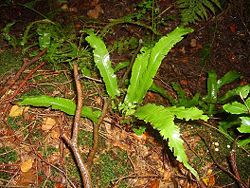Asplenium scolopendrium
| Asplenium scolopendrium | ||||||||||||||
|---|---|---|---|---|---|---|---|---|---|---|---|---|---|---|
| Scientific classification | ||||||||||||||
| ||||||||||||||
| Binomial name | ||||||||||||||
| Asplenium scolopendrium Linnaeus (1753) | ||||||||||||||
| Synonyms | ||||||||||||||
|
Hart's tongue fern (Asplenium scolopendrium) is a species of fern, which can easily be recognized by its large tongue-shaped leaves, also known as fronds. The fronds grow to 7 centimeters wide and may be more than 50 centimeters in length. It mainly grows in forests which have an alkaline soil although it has also been found growing on walls and in sewer systems. In nature the species is relatively rare, but many cultivars are grown commercially.
Morphology
The fronds are simple, undivided (uncommon for ferns) and tongue-shaped, while the basal end is heart-shaped and usually slightly broader. Young fronds are light green while older ones become darker. Mature individuals produce sori on the underside (abaxial) of their fronds in lines perpendicular to and on both sides of the ranchis (the part to which the laminar green tissue of the blade is attached)[1].
Life cycle
see also the main article on ferns
Hart's tongue fern is a homosporous species, which means that every spore can give rise to both a male and female gametophyte. The female gametophytes, or prothallia, produce antheridiogens which are a kind of pheromone. The antheridiogens spread through the surrounding soil and will induce other spores the germinate and become male. If no fertilization occurs the gametophytes of this species become bisexual, enabling self-fertilization within the haploid individual.
